
Phase-shift keying
Encyclopedia
Phase-shift keying is a digital
modulation
scheme that conveys data by changing, or modulating, the phase
of a reference signal (the carrier wave
).
Any digital modulation scheme uses a finite number of distinct signals to represent digital data. PSK uses a finite number of phases, each assigned a unique pattern of binary digit
s. Usually, each phase encodes an equal number of bits. Each pattern of bits forms the symbol that is represented by the particular phase. The demodulator, which is designed specifically for the symbol-set used by the modulator, determines the phase of the received signal and maps it back to the symbol it represents, thus recovering the original data. This requires the receiver to be able to compare the phase of the received signal to a reference signal — such a system is termed coherent (and referred to as CPSK).
Alternatively, instead of operating with respect to a constant reference wave, the broadcast can operate with respect to itself. Changes in phase of a single broadcast waveform can be considered the significant items. In this system, the demodulator determines the changes in the phase of the received signal rather than the phase (relative to a reference wave) itself. Since this scheme depends on the difference between successive phases, it is termed differential phase-shift keying (DPSK). DPSK can be significantly simpler to implement than ordinary PSK since there is no need for the demodulator to have a copy of the reference signal to determine the exact phase of the received signal (it is a non-coherent scheme). In exchange, it produces more erroneous demodulations.
ly represented data:
All convey data by changing some aspect of a base signal, the carrier wave
(usually a sinusoid), in response to a data signal. In the case of PSK, the phase is changed to represent the data signal. There are two fundamental ways of utilizing the phase of a signal in this way:
A convenient way to represent PSK schemes is on a constellation diagram
. This shows the points in the complex plane
where, in this context, the real
and imaginary
axes are termed the in-phase and quadrature axes respectively due to their 90° separation. Such a representation on perpendicular axes lends itself to straightforward implementation. The amplitude of each point along the in-phase axis is used to modulate a cosine (or sine) wave and the amplitude along the quadrature axis to modulate a sine (or cosine) wave.
In PSK, the constellation points
chosen are usually positioned with uniform angular
spacing around a circle
. This gives maximum phase-separation between adjacent points and thus the best immunity to corruption. They are positioned on a circle so that they can all be transmitted with the same energy. In this way, the moduli of the complex numbers they represent will be the same and thus so will the amplitudes needed for the cosine and sine waves. Two common examples are "binary phase-shift keying" (BPSK) which uses two phases, and "quadrature phase-shift keying" (QPSK) which uses four phases, although any number of phases may be used. Since the data to be conveyed are usually binary, the PSK scheme is usually designed with the number of constellation points being a power of 2.
 will give the probability that a single sample taken from a random process with zero-mean and unit-variance Gaussian probability density function will be greater or equal to
will give the probability that a single sample taken from a random process with zero-mean and unit-variance Gaussian probability density function will be greater or equal to  . It is a scaled form of the complementary Gaussian error function
. It is a scaled form of the complementary Gaussian error function
:
The error-rates quoted here are those in additive
white
Gaussian noise
(AWGN). These error rates are lower than those computed in fading channels, hence, are a good theoretical benchmark to compare with.
, it is widely used in existing technologies.
The wireless LAN
standard, IEEE 802.11b-1999
, uses a variety of different PSKs depending on the data-rate required. At the basic-rate of 1 Mbit/s, it uses DBPSK (differential BPSK). To provide the extended-rate of 2 Mbit/s, DQPSK is used. In reaching 5.5 Mbit/s and the full-rate of 11 Mbit/s, QPSK is employed, but has to be coupled with complementary code keying
. The higher-speed wireless LAN standard, IEEE 802.11g-2003
has eight data rates: 6, 9, 12, 18, 24, 36, 48 and 54 Mbit/s. The 6 and 9 Mbit/s modes use OFDM
modulation where each sub-carrier is BPSK modulated. The 12 and 18 Mbit/s modes use OFDM with QPSK. The fastest four modes use OFDM with forms of quadrature amplitude modulation
.
Because of its simplicity BPSK is appropriate for low-cost passive transmitters, and is used in RFID standards such as ISO/IEC 14443 which has been adopted for biometric passport
s, credit cards such as American Express
's ExpressPay, and many other applications.
Bluetooth
2 will use -DQPSK at its lower rate (2 Mbit/s) and 8-DPSK at its higher rate (3 Mbit/s) when the link between the two devices is sufficiently robust. Bluetooth 1 modulates with Gaussian minimum-shift keying
-DQPSK at its lower rate (2 Mbit/s) and 8-DPSK at its higher rate (3 Mbit/s) when the link between the two devices is sufficiently robust. Bluetooth 1 modulates with Gaussian minimum-shift keying
, a binary scheme, so either modulation choice in version 2 will yield a higher data-rate. A similar technology, IEEE 802.15.4
(the wireless standard used by ZigBee
) also relies on PSK. IEEE 802.15.4 allows the use of two frequency bands: 868–915 MHz using BPSK and at 2.4 GHz
using OQPSK.
Notably absent from these various schemes is 8-PSK. This is because its error-rate performance is close to that of 16-QAM
— it is only about 0.5 dB
better — but its data rate is only three-quarters that of 16-QAM. Thus 8-PSK is often omitted from standards and, as seen above, schemes tend to 'jump' from QPSK to 16-QAM (8-QAM is possible but difficult to implement).
Included among the exceptions is Hughnet satellite ISP. For example, the model HN7000S modem
(on KU-band satcom) uses 8-PSK modulation.
 BPSK (also sometimes called PRK, Phase Reversal Keying, or 2PSK) is the simplest form of phase shift keying (PSK). It uses two phases which are separated by 180° and so can also be termed 2-PSK. It does not particularly matter exactly where the constellation points are positioned, and in this figure they are shown on the real axis, at 0° and 180°. This modulation is the most robust of all the PSKs since it takes the highest level of noise or distortion to make the demodulator reach an incorrect decision. It is, however, only able to modulate at 1 bit/symbol (as seen in the figure) and so is unsuitable for high data-rate applications.
BPSK (also sometimes called PRK, Phase Reversal Keying, or 2PSK) is the simplest form of phase shift keying (PSK). It uses two phases which are separated by 180° and so can also be termed 2-PSK. It does not particularly matter exactly where the constellation points are positioned, and in this figure they are shown on the real axis, at 0° and 180°. This modulation is the most robust of all the PSKs since it takes the highest level of noise or distortion to make the demodulator reach an incorrect decision. It is, however, only able to modulate at 1 bit/symbol (as seen in the figure) and so is unsuitable for high data-rate applications.
In the presence of an arbitrary phase-shift introduced by the communications channel, the demodulator is unable to tell which constellation point is which. As a result, the data is often differentially encoded prior to modulation.

This yields two phases, 0 and π.
In the specific form, binary data is often conveyed with the following signals: for binary "0"
for binary "0" for binary "1"
for binary "1"
where fc is the frequency of the carrier-wave.
Hence, the signal-space can be represented by the single basis function

where 1 is represented by and 0 is represented by
and 0 is represented by  . This assignment is, of course, arbitrary.
. This assignment is, of course, arbitrary.
This use of this basis function is shown at the end of the next section in a signal timing diagram. The topmost signal is a BPSK-modulated cosine wave that the BPSK modulator would produce. The bit-stream that causes this output is shown above the signal (the other parts of this figure are relevant only to QPSK).
 or
or 
Since there is only one bit per symbol, this is also the symbol error rate.
 Sometimes this is known as quaternary PSK, quadriphase PSK, 4-PSK, or 4-QAM. (Although the root concepts of QPSK and 4-QAM are different, the resulting modulated radio waves are exactly the same.) QPSK uses four points on the constellation diagram, equispaced around a circle. With four phases, QPSK can encode two bits per symbol, shown in the diagram with gray coding to minimize the bit error rate (BER) — sometimes misperceived as twice the BER of BPSK.
Sometimes this is known as quaternary PSK, quadriphase PSK, 4-PSK, or 4-QAM. (Although the root concepts of QPSK and 4-QAM are different, the resulting modulated radio waves are exactly the same.) QPSK uses four points on the constellation diagram, equispaced around a circle. With four phases, QPSK can encode two bits per symbol, shown in the diagram with gray coding to minimize the bit error rate (BER) — sometimes misperceived as twice the BER of BPSK.
The mathematical analysis shows that QPSK can be used either to double the data rate compared with a BPSK system while maintaining the same bandwidth of the signal, or to maintain the data-rate of BPSK but halving the bandwidth needed. In this latter case, the BER of QPSK is exactly the same as the BER of BPSK - and deciding differently is a common confusion when considering or describing QPSK.
Given that radio communication channels are allocated by agencies such as the Federal Communication Commission giving a prescribed (maximum) bandwidth, the advantage of QPSK over BPSK becomes evident: QPSK transmits twice the data rate in a given bandwidth compared to BPSK - at the same BER. The engineering penalty that is paid is that QPSK transmitters and receivers are more complicated than the ones for BPSK. However, with modern electronics
technology, the penalty in cost is very moderate.
As with BPSK, there are phase ambiguity problems at the receiving end, and differentially encoded QPSK is often used in practice.

This yields the four phases π/4, 3π/4, 5π/4 and 7π/4 as needed.
This results in a two-dimensional signal space with unit basis functions

The first basis function is used as the in-phase component of the signal and the second as the quadrature component of the signal.
Hence, the signal constellation consists of the signal-space 4 points

The factors of 1/2 indicate that the total power is split equally between the two carriers.
Comparing these basis functions with that for BPSK shows clearly how QPSK can be viewed as two independent BPSK signals. Note that the signal-space points for BPSK do not need to split the symbol (bit) energy over the two carriers in the scheme shown in the BPSK constellation diagram.
QPSK systems can be implemented in a number of ways. An illustration of the major components of the transmitter and receiver structure are shown below.


As a result, the probability of bit-error for QPSK is the same as for BPSK:
However, in order to achieve the same bit-error probability as BPSK, QPSK uses twice the power (since two bits are transmitted simultaneously).
The symbol error rate is given by:
If the signal-to-noise ratio
is high (as is necessary for practical QPSK systems) the probability of symbol error may be approximated:
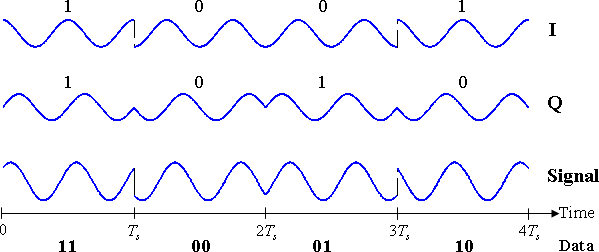 The binary data that is conveyed by this waveform is: 1 1 0 0 0 1 1 0.
The binary data that is conveyed by this waveform is: 1 1 0 0 0 1 1 0.
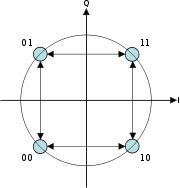 Offset quadrature phase-shift keying (OQPSK) is a variant of phase-shift keying modulation using 4 different values of the phase to transmit. It is sometimes called Staggered quadrature phase-shift keying (SQPSK).
Offset quadrature phase-shift keying (OQPSK) is a variant of phase-shift keying modulation using 4 different values of the phase to transmit. It is sometimes called Staggered quadrature phase-shift keying (SQPSK).
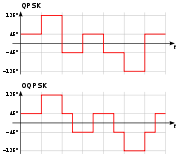 Taking four values of the phase (two bit
Taking four values of the phase (two bit
s) at a time to construct a QPSK symbol can allow the phase of the signal to jump by as much as 180° at a time. When the signal is low-pass filtered (as is typical in a transmitter), these phase-shifts result in large amplitude fluctuations, an undesirable quality in communication systems. By offsetting the timing of the odd and even bits by one bit-period, or half a symbol-period, the in-phase and quadrature components will never change at the same time. In the constellation diagram shown on the right, it can be seen that this will limit the phase-shift to no more than 90° at a time. This yields much lower amplitude fluctuations than non-offset QPSK and is sometimes preferred in practice.
The picture on the right shows the difference in the behavior of the phase between ordinary QPSK and OQPSK. It can be seen that in the first plot the phase can change by 180° at once, while in OQPSK the changes are never greater than 90°.
The modulated signal is shown below for a short segment of a random binary data-stream. Note the half symbol-period offset between the two component waves. The sudden phase-shifts occur about twice as often as for QPSK (since the signals no longer change together), but they are less severe. In other words, the magnitude of jumps is smaller in OQPSK when compared to QPSK.

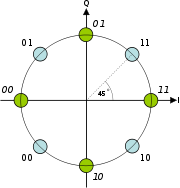 This variant of QPSK uses two identical constellations which are rotated by 45° (
This variant of QPSK uses two identical constellations which are rotated by 45° ( radians, hence the name) with respect to one another. Usually, either the even or odd symbols are used to select points from one of the constellations and the other symbols select points from the other constellation. This also reduces the phase-shifts from a maximum of 180°, but only to a maximum of 135° and so the amplitude fluctuations of
radians, hence the name) with respect to one another. Usually, either the even or odd symbols are used to select points from one of the constellations and the other symbols select points from the other constellation. This also reduces the phase-shifts from a maximum of 180°, but only to a maximum of 135° and so the amplitude fluctuations of  –QPSK are between OQPSK and non-offset QPSK.
–QPSK are between OQPSK and non-offset QPSK.
One property this modulation scheme possesses is that if the modulated signal is represented in the complex domain, it does not have any paths through the origin. In other words, the signal does not pass through the origin. This lowers the dynamical range of fluctuations in the signal which is desirable when engineering communications signals.
On the other hand, –QPSK lends itself to easy demodulation and has been adopted for use in, for example, TDMA
–QPSK lends itself to easy demodulation and has been adopted for use in, for example, TDMA
cellular telephone systems.
The modulated signal is shown below for a short segment of a random binary data-stream. The construction is the same as above for ordinary QPSK. Successive symbols are taken from the two constellations shown in the diagram. Thus, the first symbol (1 1) is taken from the 'blue' constellation and the second symbol (0 0) is taken from the 'green' constellation. Note that magnitudes of the two component waves change as they switch between constellations, but the total signal's magnitude remains constant. The phase-shifts are between those of the two previous timing-diagrams.
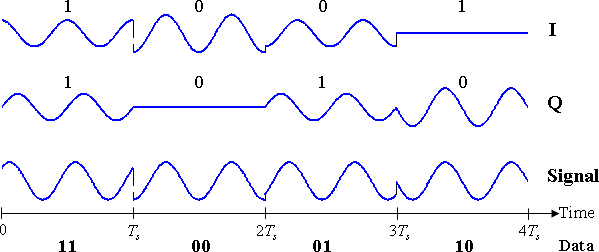
These modulations carefully shape the I and Q waveforms such that they change very smoothly, and the signal stays constant-amplitude even during signal transitions. (Rather than traveling instantly from one symbol to another, or even linearly, it travels smoothly around the constant-amplitude circle from one symbol to the next.)
The standard description of SOQPSK-TG involves ternary symbols
.
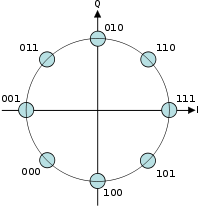 Any number of phases may be used to construct a PSK constellation but 8-PSK is usually the highest order PSK constellation deployed. With more than 8 phases, the error-rate becomes too high and there are better, though more complex, modulations available such as quadrature amplitude modulation
Any number of phases may be used to construct a PSK constellation but 8-PSK is usually the highest order PSK constellation deployed. With more than 8 phases, the error-rate becomes too high and there are better, though more complex, modulations available such as quadrature amplitude modulation
(QAM). Although any number of phases may be used, the fact that the constellation must usually deal with binary data means that the number of symbols is usually a power of 2 — this allows an equal number of bits-per-symbol.
 -PSK there is no simple expression for the symbol-error probability if
-PSK there is no simple expression for the symbol-error probability if  . Unfortunately, it can only be obtained from:
. Unfortunately, it can only be obtained from:
where
 ,
, ,
, ,
, and
and and
and  are jointly-Gaussian random variable
are jointly-Gaussian random variable
s.
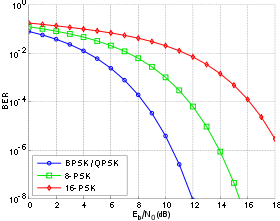 This may be approximated for high
This may be approximated for high  and high
and high  by:
by: .
.
The bit-error probability for -PSK can only be determined exactly once the bit-mapping is known. However, when Gray coding
-PSK can only be determined exactly once the bit-mapping is known. However, when Gray coding
is used, the most probable error from one symbol to the next produces only a single bit-error and .
.
(Using Gray coding allows us to approximate the Lee distance of the errors as the Hamming distance
of the errors in the decoded bitstream, which is easier to implement in hardware.)
The graph on the left compares the bit-error rates of BPSK, QPSK (which are the same, as noted above), 8-PSK and 16-PSK. It is seen that higher-order modulations exhibit higher error-rates; in exchange however they deliver a higher raw data-rate.
Bounds on the error rates of various digital modulation schemes can be computed with application of the union bound to the signal constellation.
For example, in differentially-encoded BPSK a binary '1' may be transmitted by adding 180° to the current phase and a binary '0' by adding 0° to the current phase. Another variant of DPSK is Symmetric Differential Phase Shift keying, SDPSK, where encoding would be +90° for a '1' and -90° for a '0'.
In differentially-encoded QPSK (DQPSK), the phase-shifts are 0°, 90°, 180°, -90° corresponding to data '00', '01', '11', '10'. This kind of encoding may be demodulated in the same way as for non-differential PSK but the phase ambiguities can be ignored. Thus, each received symbol is demodulated to one of the points in the constellation and a comparator
points in the constellation and a comparator
then computes the difference in phase between this received signal and the preceding one. The difference encodes the data as described above.
Symmetric Differential Quadrature Phase Shift Keying (SDQPSK) is like DQPSK, but encoding is symmetric, using phase shift values of -135°, -45°, +45° and +135°.
The modulated signal is shown below for both DBPSK and DQPSK as described above. In the figure, it is assumed that the signal starts with zero phase, and so there is a phase shift in both signals at .
.
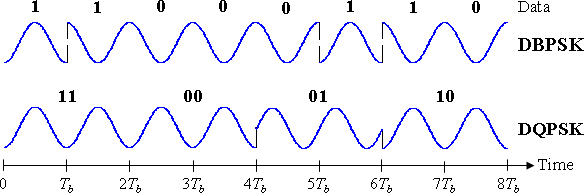 Analysis shows that differential encoding approximately doubles the error rate compared to ordinary
Analysis shows that differential encoding approximately doubles the error rate compared to ordinary  -PSK but this may be overcome by only a small increase in
-PSK but this may be overcome by only a small increase in  . Furthermore, this analysis (and the graphical results below) are based on a system in which the only corruption is additive white Gaussian noise(AWGN). However, there will also be a physical channel between the transmitter and receiver in the communication system. This channel will, in general, introduce an unknown phase-shift to the PSK signal; in these cases the differential schemes can yield a better error-rate than the ordinary schemes which rely on precise phase information.
. Furthermore, this analysis (and the graphical results below) are based on a system in which the only corruption is additive white Gaussian noise(AWGN). However, there will also be a physical channel between the transmitter and receiver in the communication system. This channel will, in general, introduce an unknown phase-shift to the PSK signal; in these cases the differential schemes can yield a better error-rate than the ordinary schemes which rely on precise phase information.
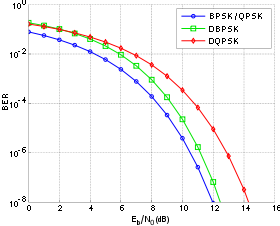 For a signal that has been differentially encoded, there is an obvious alternative method of demodulation. Instead of demodulating as usual and ignoring carrier-phase ambiguity, the phase between two successive received symbols is compared and used to determine what the data must have been. When differential encoding is used in this manner, the scheme is known as differential phase-shift keying (DPSK). Note that this is subtly different to just differentially-encoded PSK since, upon reception, the received symbols are not decoded one-by-one to constellation points but are instead compared directly to one another.
For a signal that has been differentially encoded, there is an obvious alternative method of demodulation. Instead of demodulating as usual and ignoring carrier-phase ambiguity, the phase between two successive received symbols is compared and used to determine what the data must have been. When differential encoding is used in this manner, the scheme is known as differential phase-shift keying (DPSK). Note that this is subtly different to just differentially-encoded PSK since, upon reception, the received symbols are not decoded one-by-one to constellation points but are instead compared directly to one another.
Call the received symbol in the th timeslot
th timeslot  and let it have phase
and let it have phase  . Assume without loss of generality that the phase of the carrier wave is zero. Denote the AWGN term as
. Assume without loss of generality that the phase of the carrier wave is zero. Denote the AWGN term as  . Then
. Then .
.
The decision variable for the th symbol and the
th symbol and the  th symbol is the phase difference between
th symbol is the phase difference between  and
and  . That is, if
. That is, if  is projected onto
is projected onto  , the decision is taken on the phase of the resultant complex number:
, the decision is taken on the phase of the resultant complex number:
where superscript * denotes complex conjugation. In the absence of noise, the phase of this is , the phase-shift between the two received signals which can be used to determine the data transmitted.
, the phase-shift between the two received signals which can be used to determine the data transmitted.
The probability of error for DPSK is difficult to calculate in general, but, in the case of DBPSK it is:
which, when numerically evaluated, is only slightly worse than ordinary BPSK, particularly at higher values.
values.
Using DPSK avoids the need for possibly complex carrier-recovery schemes to provide an accurate phase estimate and can be an attractive alternative to ordinary PSK.
In optical communications, the data can be modulated onto the phase of a laser
in a differential way. The modulation is a laser which emits a continuous wave
, and a Mach-Zehnder modulator which receives electrical binary data. For the case of BPSK for example, the laser transmits the field unchanged for binary '1', and with reverse polarity for '0'. The demodulator consists of a delay line interferometer
which delays one bit, so two bits can be compared at one time. In further processing, a photo diode is used to transform the optical field
into an electric current, so the information is changed back into its original state.
The bit-error rates of DBPSK and DQPSK are compared to their non-differential counterparts in the graph to the right. The loss for using DBPSK is small enough compared to the complexity reduction that it is often used in communications systems that would otherwise use BPSK. For DQPSK though, the loss in performance compared to ordinary QPSK is larger and the system designer must balance this against the reduction in complexity.
 At the
At the  time-slot call the bit to be modulated
time-slot call the bit to be modulated  , the differentially-encoded bit
, the differentially-encoded bit  and the resulting modulated signal
and the resulting modulated signal  . Assume that the constellation diagram positions the symbols at ±1 (which is BPSK). The differential encoder produces:
. Assume that the constellation diagram positions the symbols at ±1 (which is BPSK). The differential encoder produces:
where indicates binary or modulo-2
indicates binary or modulo-2
addition.
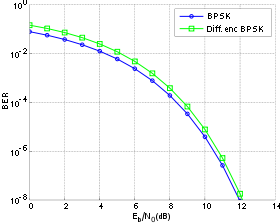 So
So  only changes state (from binary '0' to binary '1' or from binary '1' to binary '0') if
only changes state (from binary '0' to binary '1' or from binary '1' to binary '0') if  is a binary '1'. Otherwise it remains in its previous state. This is the description of differentially-encoded BPSK given above.
is a binary '1'. Otherwise it remains in its previous state. This is the description of differentially-encoded BPSK given above.
The received signal is demodulated to yield ±1 and then the differential decoder reverses the encoding procedure and produces:
±1 and then the differential decoder reverses the encoding procedure and produces: since binary subtraction is the same as binary addition.
since binary subtraction is the same as binary addition.
Therefore, if
if  and
and  differ and
differ and  if they are the same. Hence, if both
if they are the same. Hence, if both  and
and  are inverted,
are inverted,  will still be decoded correctly. Thus, the 180° phase ambiguity does not matter.
will still be decoded correctly. Thus, the 180° phase ambiguity does not matter.
Differential schemes for other PSK modulations may be devised along similar lines. The waveforms for DPSK are the same as for differentially-encoded PSK given above since the only change between the two schemes is at the receiver.
The BER curve for this example is compared to ordinary BPSK on the right. As mentioned above, whilst the error-rate is approximately doubled, the increase needed in to overcome this is small. The increase in
to overcome this is small. The increase in  required to overcome differential modulation in coded systems, however, is larger - typically about 3 dB. The performance degradation is a result of noncoherent transmission - in this case it refers to the fact that tracking of the phase is completely ignored.
required to overcome differential modulation in coded systems, however, is larger - typically about 3 dB. The performance degradation is a result of noncoherent transmission - in this case it refers to the fact that tracking of the phase is completely ignored.
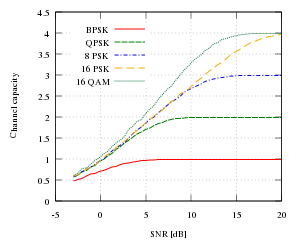 Like all M-ary modulation schemes with M = 2b symbols, when given exclusive access to a fixed bandwidth, the channel capacity of any phase shift keying modulation scheme rises to a maximum of b bits per symbol as the signal-to-noise ratio
Like all M-ary modulation schemes with M = 2b symbols, when given exclusive access to a fixed bandwidth, the channel capacity of any phase shift keying modulation scheme rises to a maximum of b bits per symbol as the signal-to-noise ratio
increases.
Digital
A digital system is a data technology that uses discrete values. By contrast, non-digital systems use a continuous range of values to represent information...
modulation
Modulation
In electronics and telecommunications, modulation is the process of varying one or more properties of a high-frequency periodic waveform, called the carrier signal, with a modulating signal which typically contains information to be transmitted...
scheme that conveys data by changing, or modulating, the phase
Phase (waves)
Phase in waves is the fraction of a wave cycle which has elapsed relative to an arbitrary point.-Formula:The phase of an oscillation or wave refers to a sinusoidal function such as the following:...
of a reference signal (the carrier wave
Carrier wave
In telecommunications, a carrier wave or carrier is a waveform that is modulated with an input signal for the purpose of conveying information. This carrier wave is usually a much higher frequency than the input signal...
).
Any digital modulation scheme uses a finite number of distinct signals to represent digital data. PSK uses a finite number of phases, each assigned a unique pattern of binary digit
Bit
A bit is the basic unit of information in computing and telecommunications; it is the amount of information stored by a digital device or other physical system that exists in one of two possible distinct states...
s. Usually, each phase encodes an equal number of bits. Each pattern of bits forms the symbol that is represented by the particular phase. The demodulator, which is designed specifically for the symbol-set used by the modulator, determines the phase of the received signal and maps it back to the symbol it represents, thus recovering the original data. This requires the receiver to be able to compare the phase of the received signal to a reference signal — such a system is termed coherent (and referred to as CPSK).
Alternatively, instead of operating with respect to a constant reference wave, the broadcast can operate with respect to itself. Changes in phase of a single broadcast waveform can be considered the significant items. In this system, the demodulator determines the changes in the phase of the received signal rather than the phase (relative to a reference wave) itself. Since this scheme depends on the difference between successive phases, it is termed differential phase-shift keying (DPSK). DPSK can be significantly simpler to implement than ordinary PSK since there is no need for the demodulator to have a copy of the reference signal to determine the exact phase of the received signal (it is a non-coherent scheme). In exchange, it produces more erroneous demodulations.
Introduction
There are three major classes of digital modulation techniques used for transmission of digitalDigital
A digital system is a data technology that uses discrete values. By contrast, non-digital systems use a continuous range of values to represent information...
ly represented data:
- Amplitude-shift keyingAmplitude-shift keyingAmplitude-shift keying is a form of modulation that represents digital data as variations in the amplitude of a carrier wave.Any digital modulation scheme uses a finite number of distinct signals to represent digital data. ASK uses a finite number of amplitudes, each assigned a unique pattern of...
(ASK) - Frequency-shift keyingFrequency-shift keyingFrequency-shift keying is a frequency modulation scheme in which digital information is transmitted through discrete frequency changes of a carrier wave. The simplest FSK is binary FSK . BFSK uses a pair of discrete frequencies to transmit binary information. With this scheme, the "1" is called...
(FSK) - Phase-shift keying (PSK)
All convey data by changing some aspect of a base signal, the carrier wave
Carrier wave
In telecommunications, a carrier wave or carrier is a waveform that is modulated with an input signal for the purpose of conveying information. This carrier wave is usually a much higher frequency than the input signal...
(usually a sinusoid), in response to a data signal. In the case of PSK, the phase is changed to represent the data signal. There are two fundamental ways of utilizing the phase of a signal in this way:
- By viewing the phasePhase (waves)Phase in waves is the fraction of a wave cycle which has elapsed relative to an arbitrary point.-Formula:The phase of an oscillation or wave refers to a sinusoidal function such as the following:...
itself as conveying the information, in which case the demodulator must have a reference signal to compare the received signal's phase against; or - By viewing the change in the phase as conveying information — differential schemes, some of which do not need a reference carrier (to a certain extent).
A convenient way to represent PSK schemes is on a constellation diagram
Constellation diagram
A constellation diagram is a representation of a signal modulated by a digital modulation scheme such as quadrature amplitude modulation or phase-shift keying. It displays the signal as a two-dimensional scatter diagram in the complex plane at symbol sampling instants...
. This shows the points in the complex plane
Complex plane
In mathematics, the complex plane or z-plane is a geometric representation of the complex numbers established by the real axis and the orthogonal imaginary axis...
where, in this context, the real
Real number
In mathematics, a real number is a value that represents a quantity along a continuum, such as -5 , 4/3 , 8.6 , √2 and π...
and imaginary
Imaginary number
An imaginary number is any number whose square is a real number less than zero. When any real number is squared, the result is never negative, but the square of an imaginary number is always negative...
axes are termed the in-phase and quadrature axes respectively due to their 90° separation. Such a representation on perpendicular axes lends itself to straightforward implementation. The amplitude of each point along the in-phase axis is used to modulate a cosine (or sine) wave and the amplitude along the quadrature axis to modulate a sine (or cosine) wave.
In PSK, the constellation points
Constellation diagram
A constellation diagram is a representation of a signal modulated by a digital modulation scheme such as quadrature amplitude modulation or phase-shift keying. It displays the signal as a two-dimensional scatter diagram in the complex plane at symbol sampling instants...
chosen are usually positioned with uniform angular
Angle
In geometry, an angle is the figure formed by two rays sharing a common endpoint, called the vertex of the angle.Angles are usually presumed to be in a Euclidean plane with the circle taken for standard with regard to direction. In fact, an angle is frequently viewed as a measure of an circular arc...
spacing around a circle
Circle
A circle is a simple shape of Euclidean geometry consisting of those points in a plane that are a given distance from a given point, the centre. The distance between any of the points and the centre is called the radius....
. This gives maximum phase-separation between adjacent points and thus the best immunity to corruption. They are positioned on a circle so that they can all be transmitted with the same energy. In this way, the moduli of the complex numbers they represent will be the same and thus so will the amplitudes needed for the cosine and sine waves. Two common examples are "binary phase-shift keying" (BPSK) which uses two phases, and "quadrature phase-shift keying" (QPSK) which uses four phases, although any number of phases may be used. Since the data to be conveyed are usually binary, the PSK scheme is usually designed with the number of constellation points being a power of 2.
Definitions
For determining error-rates mathematically, some definitions will be needed: = Energy-per-bitBitA bit is the basic unit of information in computing and telecommunications; it is the amount of information stored by a digital device or other physical system that exists in one of two possible distinct states...
= Energy-per-bitBitA bit is the basic unit of information in computing and telecommunications; it is the amount of information stored by a digital device or other physical system that exists in one of two possible distinct states... = Energy-per-symbol =
= Energy-per-symbol =  with n bits per symbol
with n bits per symbol = Bit durationBit rateIn telecommunications and computing, bit rate is the number of bits that are conveyed or processed per unit of time....
= Bit durationBit rateIn telecommunications and computing, bit rate is the number of bits that are conveyed or processed per unit of time.... = Symbol durationSymbol rateIn digital communications, symbol rate is the number of symbol changes made to the transmission medium per second using a digitally modulated signal or a line code. The Symbol rate is measured in baud or symbols/second. In the case of a line code, the symbol rate is the pulse rate in pulses/second...
= Symbol durationSymbol rateIn digital communications, symbol rate is the number of symbol changes made to the transmission medium per second using a digitally modulated signal or a line code. The Symbol rate is measured in baud or symbols/second. In the case of a line code, the symbol rate is the pulse rate in pulses/second... = Noise power spectral densitySpectral densityIn statistical signal processing and physics, the spectral density, power spectral density , or energy spectral density , is a positive real function of a frequency variable associated with a stationary stochastic process, or a deterministic function of time, which has dimensions of power per hertz...
= Noise power spectral densitySpectral densityIn statistical signal processing and physics, the spectral density, power spectral density , or energy spectral density , is a positive real function of a frequency variable associated with a stationary stochastic process, or a deterministic function of time, which has dimensions of power per hertz...
(WWattThe watt is a derived unit of power in the International System of Units , named after the Scottish engineer James Watt . The unit, defined as one joule per second, measures the rate of energy conversion.-Definition:...
/HzHertzThe hertz is the SI unit of frequency defined as the number of cycles per second of a periodic phenomenon. One of its most common uses is the description of the sine wave, particularly those used in radio and audio applications....
) = ProbabilityProbabilityProbability is ordinarily used to describe an attitude of mind towards some proposition of whose truth we arenot certain. The proposition of interest is usually of the form "Will a specific event occur?" The attitude of mind is of the form "How certain are we that the event will occur?" The...
= ProbabilityProbabilityProbability is ordinarily used to describe an attitude of mind towards some proposition of whose truth we arenot certain. The proposition of interest is usually of the form "Will a specific event occur?" The attitude of mind is of the form "How certain are we that the event will occur?" The...
of bit-error = Probability of symbol-error
= Probability of symbol-error
 will give the probability that a single sample taken from a random process with zero-mean and unit-variance Gaussian probability density function will be greater or equal to
will give the probability that a single sample taken from a random process with zero-mean and unit-variance Gaussian probability density function will be greater or equal to  . It is a scaled form of the complementary Gaussian error function
. It is a scaled form of the complementary Gaussian error functionError function
In mathematics, the error function is a special function of sigmoid shape which occurs in probability, statistics and partial differential equations...
:
-
 .
.
The error-rates quoted here are those in additive
Additive white Gaussian noise
Additive white Gaussian noise is a channel model in which the only impairment to communication is a linear addition of wideband or white noise with a constant spectral density and a Gaussian distribution of amplitude. The model does not account for fading, frequency selectivity, interference,...
white
White noise
White noise is a random signal with a flat power spectral density. In other words, the signal contains equal power within a fixed bandwidth at any center frequency...
Gaussian noise
Gaussian noise
Gaussian noise is statistical noise that has its probability density function equal to that of the normal distribution, which is also known as the Gaussian distribution. In other words, the values that the noise can take on are Gaussian-distributed. A special case is white Gaussian noise, in which...
(AWGN). These error rates are lower than those computed in fading channels, hence, are a good theoretical benchmark to compare with.
Applications
Owing to PSK's simplicity, particularly when compared with its competitor quadrature amplitude modulationQuadrature amplitude modulation
Quadrature amplitude modulation is both an analog and a digital modulation scheme. It conveys two analog message signals, or two digital bit streams, by changing the amplitudes of two carrier waves, using the amplitude-shift keying digital modulation scheme or amplitude modulation analog...
, it is widely used in existing technologies.
The wireless LAN
Wireless LAN
A wireless local area network links two or more devices using some wireless distribution method , and usually providing a connection through an access point to the wider internet. This gives users the mobility to move around within a local coverage area and still be connected to the network...
standard, IEEE 802.11b-1999
IEEE 802.11b-1999
IEEE 802.11b-1999 or 802.11b, is an amendment to the IEEE 802.11 specification that extended throughput up to 11 Mbit/s using the same 2.4 GHz band. This specification under the marketing name of Wi-Fi has been implemented all over the world...
, uses a variety of different PSKs depending on the data-rate required. At the basic-rate of 1 Mbit/s, it uses DBPSK (differential BPSK). To provide the extended-rate of 2 Mbit/s, DQPSK is used. In reaching 5.5 Mbit/s and the full-rate of 11 Mbit/s, QPSK is employed, but has to be coupled with complementary code keying
Complementary code keying
Complementary Code Keying is a modulation scheme used with wireless networks that employ the IEEE 802.11b specification. In 1999, CCK was adopted to supplement the Barker code in wireless digital networks to achieve data rate higher than 2 Mbit/s at the expense of shorter distance...
. The higher-speed wireless LAN standard, IEEE 802.11g-2003
IEEE 802.11g-2003
IEEE 802.11g-2003 or 802.11g is an amendment to the IEEE 802.11 specification that extended throughput to up to 54 Mbit/s using the same 2.4 GHz band as 802.11b. This specification under the marketing name of Wi-Fi has been implemented all over the world...
has eight data rates: 6, 9, 12, 18, 24, 36, 48 and 54 Mbit/s. The 6 and 9 Mbit/s modes use OFDM
Orthogonal frequency-division multiplexing
Orthogonal frequency-division multiplexing is a method of encoding digital data on multiple carrier frequencies. OFDM has developed into a popular scheme for wideband digital communication, whether wireless or over copper wires, used in applications such as digital television and audio...
modulation where each sub-carrier is BPSK modulated. The 12 and 18 Mbit/s modes use OFDM with QPSK. The fastest four modes use OFDM with forms of quadrature amplitude modulation
Quadrature amplitude modulation
Quadrature amplitude modulation is both an analog and a digital modulation scheme. It conveys two analog message signals, or two digital bit streams, by changing the amplitudes of two carrier waves, using the amplitude-shift keying digital modulation scheme or amplitude modulation analog...
.
Because of its simplicity BPSK is appropriate for low-cost passive transmitters, and is used in RFID standards such as ISO/IEC 14443 which has been adopted for biometric passport
Biometric passport
A biometric passport, also known as an e-passport or ePassport, is a combined paper and electronic passport that contains biometric information that can be used to authenticate the identity of travelers...
s, credit cards such as American Express
American Express
American Express Company or AmEx, is an American multinational financial services corporation headquartered in Three World Financial Center, Manhattan, New York City, New York, United States. Founded in 1850, it is one of the 30 components of the Dow Jones Industrial Average. The company is best...
's ExpressPay, and many other applications.
Bluetooth
Bluetooth
Bluetooth is a proprietary open wireless technology standard for exchanging data over short distances from fixed and mobile devices, creating personal area networks with high levels of security...
2 will use
 -DQPSK at its lower rate (2 Mbit/s) and 8-DPSK at its higher rate (3 Mbit/s) when the link between the two devices is sufficiently robust. Bluetooth 1 modulates with Gaussian minimum-shift keying
-DQPSK at its lower rate (2 Mbit/s) and 8-DPSK at its higher rate (3 Mbit/s) when the link between the two devices is sufficiently robust. Bluetooth 1 modulates with Gaussian minimum-shift keyingMinimum-shift keying
In digital modulation, minimum-shift keying is a type of continuous-phase frequency-shift keying that was developed in the late 1950s and 1960s. Similar to OQPSK, MSK is encoded with bits alternating between quadrature components, with the Q component delayed by half the symbol period. However,...
, a binary scheme, so either modulation choice in version 2 will yield a higher data-rate. A similar technology, IEEE 802.15.4
IEEE 802.15.4
IEEE 802.15.4 is a standard which specifies the physical layer and media access control for low-rate wireless personal area networks . It is maintained by the IEEE 802.15 working group....
(the wireless standard used by ZigBee
ZigBee
ZigBee is a specification for a suite of high level communication protocols using small, low-power digital radios based on an IEEE 802 standard for personal area networks. Applications include wireless light switches, electrical meters with in-home-displays, and other consumer and industrial...
) also relies on PSK. IEEE 802.15.4 allows the use of two frequency bands: 868–915 MHz using BPSK and at 2.4 GHz
Hertz
The hertz is the SI unit of frequency defined as the number of cycles per second of a periodic phenomenon. One of its most common uses is the description of the sine wave, particularly those used in radio and audio applications....
using OQPSK.
Notably absent from these various schemes is 8-PSK. This is because its error-rate performance is close to that of 16-QAM
Quadrature amplitude modulation
Quadrature amplitude modulation is both an analog and a digital modulation scheme. It conveys two analog message signals, or two digital bit streams, by changing the amplitudes of two carrier waves, using the amplitude-shift keying digital modulation scheme or amplitude modulation analog...
— it is only about 0.5 dB
Decibel
The decibel is a logarithmic unit that indicates the ratio of a physical quantity relative to a specified or implied reference level. A ratio in decibels is ten times the logarithm to base 10 of the ratio of two power quantities...
better — but its data rate is only three-quarters that of 16-QAM. Thus 8-PSK is often omitted from standards and, as seen above, schemes tend to 'jump' from QPSK to 16-QAM (8-QAM is possible but difficult to implement).
Included among the exceptions is Hughnet satellite ISP. For example, the model HN7000S modem
(on KU-band satcom) uses 8-PSK modulation.
Binary phase-shift keying (BPSK)

In the presence of an arbitrary phase-shift introduced by the communications channel, the demodulator is unable to tell which constellation point is which. As a result, the data is often differentially encoded prior to modulation.
Implementation
The general form for BPSK follows the equation:
This yields two phases, 0 and π.
In the specific form, binary data is often conveyed with the following signals:
 for binary "0"
for binary "0" for binary "1"
for binary "1"where fc is the frequency of the carrier-wave.
Hence, the signal-space can be represented by the single basis function
Basis function
In mathematics, a basis function is an element of a particular basis for a function space. Every continuous function in the function space can be represented as a linear combination of basis functions, just as every vector in a vector space can be represented as a linear combination of basis...

where 1 is represented by
 and 0 is represented by
and 0 is represented by  . This assignment is, of course, arbitrary.
. This assignment is, of course, arbitrary.This use of this basis function is shown at the end of the next section in a signal timing diagram. The topmost signal is a BPSK-modulated cosine wave that the BPSK modulator would produce. The bit-stream that causes this output is shown above the signal (the other parts of this figure are relevant only to QPSK).
Bit error rate
The bit error rate (BER) of BPSK in AWGN can be calculated as: or
or 
Since there is only one bit per symbol, this is also the symbol error rate.
Quadrature phase-shift keying (QPSK)

The mathematical analysis shows that QPSK can be used either to double the data rate compared with a BPSK system while maintaining the same bandwidth of the signal, or to maintain the data-rate of BPSK but halving the bandwidth needed. In this latter case, the BER of QPSK is exactly the same as the BER of BPSK - and deciding differently is a common confusion when considering or describing QPSK.
Given that radio communication channels are allocated by agencies such as the Federal Communication Commission giving a prescribed (maximum) bandwidth, the advantage of QPSK over BPSK becomes evident: QPSK transmits twice the data rate in a given bandwidth compared to BPSK - at the same BER. The engineering penalty that is paid is that QPSK transmitters and receivers are more complicated than the ones for BPSK. However, with modern electronics
Electronics
Electronics is the branch of science, engineering and technology that deals with electrical circuits involving active electrical components such as vacuum tubes, transistors, diodes and integrated circuits, and associated passive interconnection technologies...
technology, the penalty in cost is very moderate.
As with BPSK, there are phase ambiguity problems at the receiving end, and differentially encoded QPSK is often used in practice.
Implementation
The implementation of QPSK is more general than that of BPSK and also indicates the implementation of higher-order PSK. Writing the symbols in the constellation diagram in terms of the sine and cosine waves used to transmit them:
This yields the four phases π/4, 3π/4, 5π/4 and 7π/4 as needed.
This results in a two-dimensional signal space with unit basis functions


The first basis function is used as the in-phase component of the signal and the second as the quadrature component of the signal.
Hence, the signal constellation consists of the signal-space 4 points

The factors of 1/2 indicate that the total power is split equally between the two carriers.
Comparing these basis functions with that for BPSK shows clearly how QPSK can be viewed as two independent BPSK signals. Note that the signal-space points for BPSK do not need to split the symbol (bit) energy over the two carriers in the scheme shown in the BPSK constellation diagram.
QPSK systems can be implemented in a number of ways. An illustration of the major components of the transmitter and receiver structure are shown below.


Bit error rate
Although QPSK can be viewed as a quaternary modulation, it is easier to see it as two independently modulated quadrature carriers. With this interpretation, the even (or odd) bits are used to modulate the in-phase component of the carrier, while the odd (or even) bits are used to modulate the quadrature-phase component of the carrier. BPSK is used on both carriers and they can be independently demodulated.As a result, the probability of bit-error for QPSK is the same as for BPSK:

However, in order to achieve the same bit-error probability as BPSK, QPSK uses twice the power (since two bits are transmitted simultaneously).
The symbol error rate is given by:
 |
 |
 . . |
If the signal-to-noise ratio
Signal-to-noise ratio
Signal-to-noise ratio is a measure used in science and engineering that compares the level of a desired signal to the level of background noise. It is defined as the ratio of signal power to the noise power. A ratio higher than 1:1 indicates more signal than noise...
is high (as is necessary for practical QPSK systems) the probability of symbol error may be approximated:

QPSK signal in the time domain

- The odd bits, highlighted here, contribute to the in-phase component: 1 1 0 0 0 1 1 0
- The even bits, highlighted here, contribute to the quadrature-phase component: 1 1 0 0 0 1 1 0
Offset QPSK (OQPSK)


Bit
A bit is the basic unit of information in computing and telecommunications; it is the amount of information stored by a digital device or other physical system that exists in one of two possible distinct states...
s) at a time to construct a QPSK symbol can allow the phase of the signal to jump by as much as 180° at a time. When the signal is low-pass filtered (as is typical in a transmitter), these phase-shifts result in large amplitude fluctuations, an undesirable quality in communication systems. By offsetting the timing of the odd and even bits by one bit-period, or half a symbol-period, the in-phase and quadrature components will never change at the same time. In the constellation diagram shown on the right, it can be seen that this will limit the phase-shift to no more than 90° at a time. This yields much lower amplitude fluctuations than non-offset QPSK and is sometimes preferred in practice.
The picture on the right shows the difference in the behavior of the phase between ordinary QPSK and OQPSK. It can be seen that in the first plot the phase can change by 180° at once, while in OQPSK the changes are never greater than 90°.
The modulated signal is shown below for a short segment of a random binary data-stream. Note the half symbol-period offset between the two component waves. The sudden phase-shifts occur about twice as often as for QPSK (since the signals no longer change together), but they are less severe. In other words, the magnitude of jumps is smaller in OQPSK when compared to QPSK.

π/4–QPSK

 radians, hence the name) with respect to one another. Usually, either the even or odd symbols are used to select points from one of the constellations and the other symbols select points from the other constellation. This also reduces the phase-shifts from a maximum of 180°, but only to a maximum of 135° and so the amplitude fluctuations of
radians, hence the name) with respect to one another. Usually, either the even or odd symbols are used to select points from one of the constellations and the other symbols select points from the other constellation. This also reduces the phase-shifts from a maximum of 180°, but only to a maximum of 135° and so the amplitude fluctuations of  –QPSK are between OQPSK and non-offset QPSK.
–QPSK are between OQPSK and non-offset QPSK.One property this modulation scheme possesses is that if the modulated signal is represented in the complex domain, it does not have any paths through the origin. In other words, the signal does not pass through the origin. This lowers the dynamical range of fluctuations in the signal which is desirable when engineering communications signals.
On the other hand,
 –QPSK lends itself to easy demodulation and has been adopted for use in, for example, TDMA
–QPSK lends itself to easy demodulation and has been adopted for use in, for example, TDMATime division multiple access
Time division multiple access is a channel access method for shared medium networks. It allows several users to share the same frequency channel by dividing the signal into different time slots. The users transmit in rapid succession, one after the other, each using its own time slot. This...
cellular telephone systems.
The modulated signal is shown below for a short segment of a random binary data-stream. The construction is the same as above for ordinary QPSK. Successive symbols are taken from the two constellations shown in the diagram. Thus, the first symbol (1 1) is taken from the 'blue' constellation and the second symbol (0 0) is taken from the 'green' constellation. Note that magnitudes of the two component waves change as they switch between constellations, but the total signal's magnitude remains constant. The phase-shifts are between those of the two previous timing-diagrams.

SOQPSK
The license-free shaped-offset QPSK (SOQPSK) is interoperable with Feher-patented QPSK (FQPSK), in the sense that an integrate-and-dump offset QPSK detector produces the same output no matter which kind of transmitter is used https://dspace.byu.edu/bitstream/1877/121/1/NelsonPerrinsRice_common_detectors.pdf.These modulations carefully shape the I and Q waveforms such that they change very smoothly, and the signal stays constant-amplitude even during signal transitions. (Rather than traveling instantly from one symbol to another, or even linearly, it travels smoothly around the constant-amplitude circle from one symbol to the next.)
The standard description of SOQPSK-TG involves ternary symbols
Ternary signal
In telecommunication, a ternary signal is a signal that can assume, at any given instant, one of three states or significant conditions, such as power level, phase position, pulse duration, or frequency....
.
DPQPSK
Dual-polarization quadrature phase shift keying (DPQPSK) or dual-polarization QPSK - involves the polarization multiplexing of two different QPSK signals, thus improving the spectral efficiency by a factor of 2. This is a cost-effective alternative, to utilizing 16-PSK instead of QPSK to double the spectral efficiency.Higher-order PSK

Quadrature amplitude modulation
Quadrature amplitude modulation is both an analog and a digital modulation scheme. It conveys two analog message signals, or two digital bit streams, by changing the amplitudes of two carrier waves, using the amplitude-shift keying digital modulation scheme or amplitude modulation analog...
(QAM). Although any number of phases may be used, the fact that the constellation must usually deal with binary data means that the number of symbols is usually a power of 2 — this allows an equal number of bits-per-symbol.
Bit error rate
For the general -PSK there is no simple expression for the symbol-error probability if
-PSK there is no simple expression for the symbol-error probability if  . Unfortunately, it can only be obtained from:
. Unfortunately, it can only be obtained from:
where
 ,
, ,
, ,
, and
and and
and  are jointly-Gaussian random variable
are jointly-Gaussian random variableRandom variable
In probability and statistics, a random variable or stochastic variable is, roughly speaking, a variable whose value results from a measurement on some type of random process. Formally, it is a function from a probability space, typically to the real numbers, which is measurable functionmeasurable...
s.

 and high
and high  by:
by: .
.The bit-error probability for
 -PSK can only be determined exactly once the bit-mapping is known. However, when Gray coding
-PSK can only be determined exactly once the bit-mapping is known. However, when Gray codingGray code
The reflected binary code, also known as Gray code after Frank Gray, is a binary numeral system where two successive values differ in only one bit. It is a non-weighted code....
is used, the most probable error from one symbol to the next produces only a single bit-error and
 .
.(Using Gray coding allows us to approximate the Lee distance of the errors as the Hamming distance
Hamming distance
In information theory, the Hamming distance between two strings of equal length is the number of positions at which the corresponding symbols are different...
of the errors in the decoded bitstream, which is easier to implement in hardware.)
The graph on the left compares the bit-error rates of BPSK, QPSK (which are the same, as noted above), 8-PSK and 16-PSK. It is seen that higher-order modulations exhibit higher error-rates; in exchange however they deliver a higher raw data-rate.
Bounds on the error rates of various digital modulation schemes can be computed with application of the union bound to the signal constellation.
Differential encoding
Differential phase shift keying (DPSK) is a common form of phase modulation that conveys data by changing the phase of the carrier wave. As mentioned for BPSK and QPSK there is an ambiguity of phase if the constellation is rotated by some effect in the communications channel through which the signal passes. This problem can be overcome by using the data to change rather than set the phase.For example, in differentially-encoded BPSK a binary '1' may be transmitted by adding 180° to the current phase and a binary '0' by adding 0° to the current phase. Another variant of DPSK is Symmetric Differential Phase Shift keying, SDPSK, where encoding would be +90° for a '1' and -90° for a '0'.
In differentially-encoded QPSK (DQPSK), the phase-shifts are 0°, 90°, 180°, -90° corresponding to data '00', '01', '11', '10'. This kind of encoding may be demodulated in the same way as for non-differential PSK but the phase ambiguities can be ignored. Thus, each received symbol is demodulated to one of the
 points in the constellation and a comparator
points in the constellation and a comparatorComparator
In electronics, a comparator is a device that compares two voltages or currents and switches its output to indicate which is larger. They are commonly used in devices such as Analog-to-digital converters .- Input voltage range :...
then computes the difference in phase between this received signal and the preceding one. The difference encodes the data as described above.
Symmetric Differential Quadrature Phase Shift Keying (SDQPSK) is like DQPSK, but encoding is symmetric, using phase shift values of -135°, -45°, +45° and +135°.
The modulated signal is shown below for both DBPSK and DQPSK as described above. In the figure, it is assumed that the signal starts with zero phase, and so there is a phase shift in both signals at
 .
.
 -PSK but this may be overcome by only a small increase in
-PSK but this may be overcome by only a small increase in  . Furthermore, this analysis (and the graphical results below) are based on a system in which the only corruption is additive white Gaussian noise(AWGN). However, there will also be a physical channel between the transmitter and receiver in the communication system. This channel will, in general, introduce an unknown phase-shift to the PSK signal; in these cases the differential schemes can yield a better error-rate than the ordinary schemes which rely on precise phase information.
. Furthermore, this analysis (and the graphical results below) are based on a system in which the only corruption is additive white Gaussian noise(AWGN). However, there will also be a physical channel between the transmitter and receiver in the communication system. This channel will, in general, introduce an unknown phase-shift to the PSK signal; in these cases the differential schemes can yield a better error-rate than the ordinary schemes which rely on precise phase information.Demodulation

Call the received symbol in the
 th timeslot
th timeslot  and let it have phase
and let it have phase  . Assume without loss of generality that the phase of the carrier wave is zero. Denote the AWGN term as
. Assume without loss of generality that the phase of the carrier wave is zero. Denote the AWGN term as  . Then
. Then .
.The decision variable for the
 th symbol and the
th symbol and the  th symbol is the phase difference between
th symbol is the phase difference between  and
and  . That is, if
. That is, if  is projected onto
is projected onto  , the decision is taken on the phase of the resultant complex number:
, the decision is taken on the phase of the resultant complex number:
where superscript * denotes complex conjugation. In the absence of noise, the phase of this is
 , the phase-shift between the two received signals which can be used to determine the data transmitted.
, the phase-shift between the two received signals which can be used to determine the data transmitted.The probability of error for DPSK is difficult to calculate in general, but, in the case of DBPSK it is:

which, when numerically evaluated, is only slightly worse than ordinary BPSK, particularly at higher
 values.
values.Using DPSK avoids the need for possibly complex carrier-recovery schemes to provide an accurate phase estimate and can be an attractive alternative to ordinary PSK.
In optical communications, the data can be modulated onto the phase of a laser
Laser
A laser is a device that emits light through a process of optical amplification based on the stimulated emission of photons. The term "laser" originated as an acronym for Light Amplification by Stimulated Emission of Radiation...
in a differential way. The modulation is a laser which emits a continuous wave
Continuous wave
A continuous wave or continuous waveform is an electromagnetic wave of constant amplitude and frequency; and in mathematical analysis, of infinite duration. Continuous wave is also the name given to an early method of radio transmission, in which a carrier wave is switched on and off...
, and a Mach-Zehnder modulator which receives electrical binary data. For the case of BPSK for example, the laser transmits the field unchanged for binary '1', and with reverse polarity for '0'. The demodulator consists of a delay line interferometer
Delay line interferometer
A delay line interferometer can be a Mach-Zehnder interferometer or Michelson interferometer based on two-beam interference, in which one beam is time-delayed to the other by a desired interval....
which delays one bit, so two bits can be compared at one time. In further processing, a photo diode is used to transform the optical field
Optical field
The optical field is a term used in physics and vector calculus to designate the electric field shown as E in the electromagnetic wave equation which can be derived from Maxwell's Equations...
into an electric current, so the information is changed back into its original state.
The bit-error rates of DBPSK and DQPSK are compared to their non-differential counterparts in the graph to the right. The loss for using DBPSK is small enough compared to the complexity reduction that it is often used in communications systems that would otherwise use BPSK. For DQPSK though, the loss in performance compared to ordinary QPSK is larger and the system designer must balance this against the reduction in complexity.
Example: Differentially-encoded BPSK

 time-slot call the bit to be modulated
time-slot call the bit to be modulated  , the differentially-encoded bit
, the differentially-encoded bit  and the resulting modulated signal
and the resulting modulated signal  . Assume that the constellation diagram positions the symbols at ±1 (which is BPSK). The differential encoder produces:
. Assume that the constellation diagram positions the symbols at ±1 (which is BPSK). The differential encoder produces:
where
 indicates binary or modulo-2
indicates binary or modulo-2Modular arithmetic
In mathematics, modular arithmetic is a system of arithmetic for integers, where numbers "wrap around" after they reach a certain value—the modulus....
addition.

 only changes state (from binary '0' to binary '1' or from binary '1' to binary '0') if
only changes state (from binary '0' to binary '1' or from binary '1' to binary '0') if  is a binary '1'. Otherwise it remains in its previous state. This is the description of differentially-encoded BPSK given above.
is a binary '1'. Otherwise it remains in its previous state. This is the description of differentially-encoded BPSK given above.The received signal is demodulated to yield
 ±1 and then the differential decoder reverses the encoding procedure and produces:
±1 and then the differential decoder reverses the encoding procedure and produces: since binary subtraction is the same as binary addition.
since binary subtraction is the same as binary addition.Therefore,
 if
if  and
and  differ and
differ and  if they are the same. Hence, if both
if they are the same. Hence, if both  and
and  are inverted,
are inverted,  will still be decoded correctly. Thus, the 180° phase ambiguity does not matter.
will still be decoded correctly. Thus, the 180° phase ambiguity does not matter.Differential schemes for other PSK modulations may be devised along similar lines. The waveforms for DPSK are the same as for differentially-encoded PSK given above since the only change between the two schemes is at the receiver.
The BER curve for this example is compared to ordinary BPSK on the right. As mentioned above, whilst the error-rate is approximately doubled, the increase needed in
 to overcome this is small. The increase in
to overcome this is small. The increase in  required to overcome differential modulation in coded systems, however, is larger - typically about 3 dB. The performance degradation is a result of noncoherent transmission - in this case it refers to the fact that tracking of the phase is completely ignored.
required to overcome differential modulation in coded systems, however, is larger - typically about 3 dB. The performance degradation is a result of noncoherent transmission - in this case it refers to the fact that tracking of the phase is completely ignored.Channel capacity

Signal-to-noise ratio
Signal-to-noise ratio is a measure used in science and engineering that compares the level of a desired signal to the level of background noise. It is defined as the ratio of signal power to the noise power. A ratio higher than 1:1 indicates more signal than noise...
increases.
See also
- Differential codingDifferential codingIn digital communications, differential coding is a technique used to provide unambiguous signal reception when using some types of modulation...
- Filtered symmetric differential phase-shift keyingFiltered symmetric differential phase-shift keyingIn telecommunication, filtered symmetric differential phase-shift keying is a method of encoding information for digital transmission in which:...
- ModulationModulationIn electronics and telecommunications, modulation is the process of varying one or more properties of a high-frequency periodic waveform, called the carrier signal, with a modulating signal which typically contains information to be transmitted...
— for an overview of all modulation schemes - Phase modulationPhase modulationPhase modulation is a form of modulation that represents information as variations in the instantaneous phase of a carrier wave.Unlike its more popular counterpart, frequency modulation , PM is not very widely used for radio transmissions...
(PM) — the analogue equivalent of PSK - Polar modulationPolar modulationPolar modulation is analogous to quadrature modulation in the same way that polar coordinates are analogous to Cartesian coordinates. Quadrature modulation makes use of Cartesian coordinates, x and y. When considering quadrature modulation, the x axis is called the I axis, and the y axis is...
- PSK31PSK31PSK31 or "Phase Shift Keying, 31 Baud" is a digital radio modulation mode, used primarily in the amateur radio field to conduct real-time keyboard-to-keyboard informal text chat between amateur radio operators.- History :...
- PSK63PSK63PSK63 or Phase Shift Keying, 63 Baud, is a digital radio modulation mode used primarily in the amateur radio field to conduct real-time keyboard-to-keyboard informal text chat between amateur radio operators.- History :...

